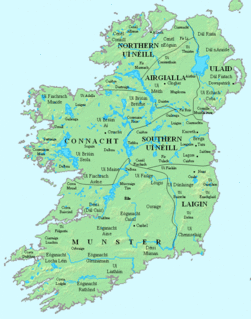The Second Battle of Athenry took place at Athenry in Ireland on 10 August 1316 during the Bruce campaign in Ireland.

West Connacht was a kingdom of Gaelic Ireland, associated geographically with present-day County Galway, particularly the area known more commonly today as Connemara. The kingdom represented the core homeland of the Connachta's Uí Briúin Seóla kindred and although they ruled, there were smaller groups of other Gaels in the area, such as the Delbhna Tir Dha Locha and the Conmhaícne Mara. It existed from 1051 onwards, after the Ó Conchobhair, Kings of Connacht, pushed the Ó Flaithbheartaigh to the West of Lough Corrib, from their original territory of Maigh Seóla. Iar Connacht remained a subordinate túath of Connacht, until the 13th century, after which it was more independent.

Maigh Seóla, also known as Hy Briuin Seola, was the territory that included land along the east shore of Lough Corrib in County Galway, Ireland. It was bounded to the east by the Uí Maine vassal kingdom of Soghain and extended roughly from what is now Clarinbridge in the south to Knockmaa Hill in the north. Its rulers belonged to the Uí Briúin Seóla and are sometimes found in the annals under the title "King of Uí Briúin" and "King of South Connacht". The earliest identifiable kings belonged to the line that became the Clann Cosgraigh. However in later times the line which would become the Muintir Murchada, under the O'Flaherty chiefs, monopolized the kingship.

O'Flaherty, is an Irish Gaelic clan based most prominently in what is today County Galway. The clan name originated in the 10th century as a derivative of its founder Flaithbheartach mac Eimhin. They descend in the paternal line from the Connachta's Uí Briúin Seóla. They were originally kings of Maigh Seóla and Muintir Murchada and as members of the Uí Briúin were kinsmen of the Ó Conchubhair and Mac Diarmada amongst others. After their king Cathal mac Tigernán lost out to Áed in Gai Bernaig in the 11th century, the family were pushed further west to Iar Connacht, a territory associated with Connemara today. They continued to rule this land until the 16th century.
Hugh McHugh Breifne O'Conor was king of Connacht, Ireland, in 1342. He was the last of the Clan Murtagh O'Conor to hold this position. He died in 1350, as the O'Connor Breifne, some eight years after being expelled. His father, a son of Cathal O'Connor had briefly made a bid for the kingship in 1309-10 from a power-base established in Breifne O'Rourke.
McHugh is a common surname of Irish origin. It is an anglicisation of the original Irish Mac Aodha, meaning literally "Son of Aodh". Aodh was a popular male given name in mediaeval Gaelic Ireland. It was traditionally written in English-language documents as Hugh, an unrelated name of Frankish origin.

Muintir Murchada was the name of an Irish territory which derived its name from the ruling dynasty, who were in turn a branch of the Uí Briúin. The name was derived from Murchadh mac Maenach, King of Uí Briúin Seóla, who died 891.
Donn mac Cumasgach was a king of Maigh Seóla who died in 752.
Máel Sechlain Mac Áeda was the Archbishop of Tuam 1312 – 10 August 1348.
Tadhg Ó Cellaigh, also known as Tadhg mac Domnall O Cellaigh was King of Uí Maine and Chief of the Name.
Muireadhach Ua Dubhthaigh was an Archbishop of Connacht, in Ireland.
Rúaidhri Ua Flaithbheartaigh was King of Iar Connacht.
Donn Óge Mag Oireachtaigh was the lord of Clann Taidg.
Clann Cosgraigh was a branch of the Uí Briúin dynasty and also the name of the district on the eastern side of Lough Corrib, County Galway which they inhabited and ruled prior to the Norman invasion.
Murchad mac Flann mac Glethneachan was King of Maigh Seóla.
Muireadhach mac Aedh, Lord of Clann Cosgraigh, died 1124. He was a distant cousin of the Muintir Murchada, of whom the O'Flahertys were chiefs.
Máelsechlain Mac Áeda was Lord of Clann Cosgraigh.
John na Mointech Mac Áeda, Chief of the Name, died 1582.
Tom McHugh, County Councillor and Mayor of County Galway 2009-10.
The Cenél Conaill, or "kindred of Conall", are a branch of the Northern Uí Néill, who claim descent from Conall Gulban, son of Niall of the Nine Hostages, and allegedly the first Irish nobleman to convert to Christianity. Their kingdom was known as Tír Conaill, with their powerbase at Mag Ithe in the Finn valley, however they gradually expanded to cover what is now counties Donegal and Fermanagh. The Cenél Conaill clashed regularly with their kin the Cenél nEogain, eventually capturing the latters original power-base of Ailech in the Inishowen peninsula—in modern-day County Donegal—by the 12th century.


